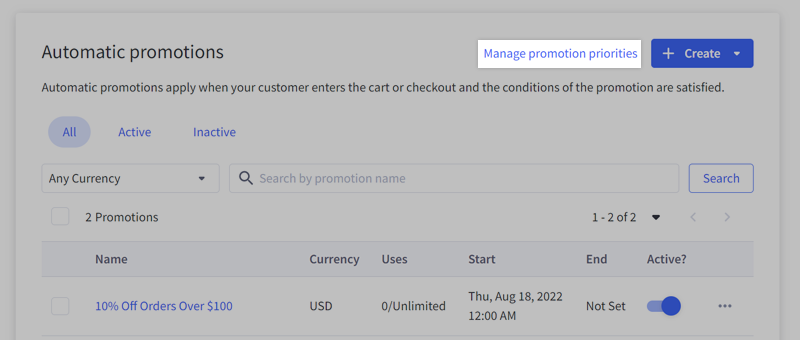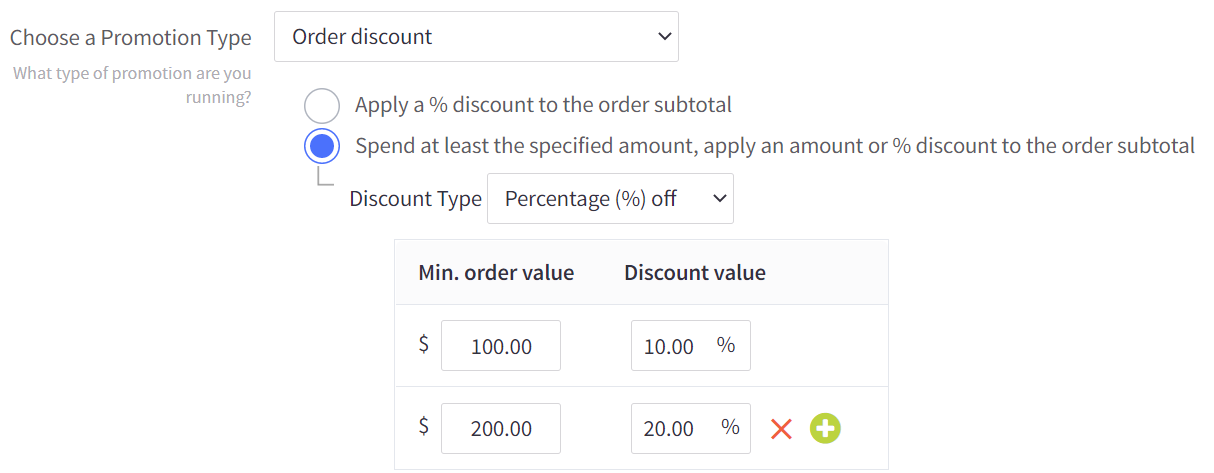- 14 May 2024
- 5 Minutes to read
- Print
- DarkLight
- PDF
Automatic Promotions
- Updated on 14 May 2024
- 5 Minutes to read
- Print
- DarkLight
- PDF
Automatic Promotions are a way to set up product discounts based on whether the customer's shopping cart has met specific criteria, such as including certain products or brands, reaching a set order amount, or even whether the customer has purchased before. Shoppers won't need to enter a coupon code, as the promotion is automatically applied, leading to less friction on the checkout.
Sales are easy to schedule in advance, as promotions can be created with a set start and end date. This lets you focus on promoting your sale through social media and email marketing rather than manually managing the promotion in the control panel.
Due to the nature of Automatic Promotions, they will not be apparent to the customer until after they have added products to their cart. For this reason, we recommend advertising your discounts with a marketing banner or on your store's carousel.
The advanced editor offers additional functionality for creating promotions. Exclude promotions, limit promotions to certain days or weeks, create fixed-price promotions, and more.
Types of Automatic Promotions
Shipping discounts
- Order at least X units of product Y, and get free shipping to specific shipping zones.
- Orders totaling more than the amount get free shipping to specific shipping zones.
So that you know... If your discount conflicts with your shipping zone setup, the promotion will take priority over the shipping zone rule.
Product discounts
- Buy one get one free
- Buy one, get something else free
- Buy (X units) of Product A, get (Y units) of Product B for $ or % off per unit.
- Apply an amount or % off to Product X
Brand discounts
- Apply a $ or % discount to each item in one or more brands (can exclude certain brands)
Category discounts
- Apply an amount or % of each item in one or more categories (can exclude specific subcategories)
- Buy X units in (Category A), and get Y additional units in the same category free (must be of equal or lesser value)
- Apply a tiered discount to applicable products based on the number of items ordered within one or more categories.
Order discounts
- Spend at least the specified amount, and apply an amount or % discount to the order subtotal.
- Spend at least the specified amount, and get one unit of Product Y for an amount or % off.
- Spend at least the specified amount, and get Y% off (one or all) unit(s) of the (most minor or most) expensive item(s) in the cart.
Customer discounts
- The discount amount for repeat customers
- X% discount for repeat customers
Are you offering a free item? If you use one of the Buy One Get One discounts, there will be an additional option to automatically add any eligible free product to the shopper's cart. By default, this option is enabled. If you disable it, shoppers must click the eligible banner prompt on the cart page and manually add the free product to their cart.
Viewing Automatic Promotions
Go to Marketing › Promotions to see your active and disabled promotions in the Promotions Manager.

In addition to the list of promotions, you can also see the following statistics and settings:
- Currency — the currency the promotion will affect. Percentage-based discounts can optionally be applied to "All Currencies."
- Uses — how often the promotion has been triggered / total number of allowed uses
- Start — the date and time for the promotion to activate
- End — the date and time for the promotion to expire
- Active? — whether or not the promotion is currently active; toggle to enable/disable

Use the tabs to filter your promotions and view only active or inactive promotions. By default, you will see all promotions. You can also filter by currency using the dropdown menu. You will find all the currencies set up under Settings › Currencies available as filters. This allows you to combine the two sets of filters for even greater precision, such as only displaying active promotions available to customers using Canadian Dollars.
Use the search field to search by promotion name. This is extremely useful if your store has more than one page of promotions or when you're looking for a specific promotion.
Creating an Automatic Promotion
To create an automatic promotion, go to Marketing › Promotions and click + Create with Standard Editor
Enter a Summary. The promotion name is an internal name that you can use to keep track of your discounts.

Select a Targeting for which customers have access to the promotion. The only mandatory targeting rule to use is the currency.

You then will be able to add other optional targeting rules based on either; Customer Group, Customer Segmentation, or Shipping Destination.

Next, you need to apply what Rules will need to be satisfied to receive the discount offered.

There are several pre-built rules, but you can also create a custom control.

Finally, you need to set a Usage Limit to minimize or maximize the number of times customers can take advantage of the promotion. 
Manage Promotion Priorities
Multiple promotions can apply to the same order. The sequence in which these promotions are triggered is configured under Manage promotion priorities.

Promotions will trigger (top to bottom) in the sequence that appears in this list. Click and drag promotions up or down in the list to change their priority. Priority assignment is essential as it can significantly affect how your various promotions interact with each other on orders.
For example, you can have one promotion that gives shoppers free shipping on orders over $100 and another that offers 10% off orders over $100.
If the priority is set so that the free shipping promotion is applied first and the 10% discount is applied second, then when the shopper's cart reaches $100, they would (somewhat) qualify for free shipping, then (second) receive 10% off their order, bringing the order total to $90. In this scenario, the shopper has effectively qualified for free shipping by only spending $90, which is probably not what you intended.

You can remedy this by changing the priority so that the 10% discount happens first and the free shipping promotion runs second. That way, the shopper receives the 10% discount but will still need to spend at least $100 before qualifying for free shipping.

STOP AFTER THIS RULE
In addition to changing the order of operations, you can also use Stop after this rule to prevent subsequent promotions from firing after a specific promotion has been triggered.
For example, you may have promotions for 10% off orders over $100 and 20% off orders over $200. You intend the shopper to receive one of these discounts, but not both.

In this case, you should prioritize the more significant discount and check Stop after this rule, so the smaller discount isn't also applied to the order.

This example is to illustrate how Stopping after this rule can work. A better way to implement the above discounts would be to use multiple discount tiers in the same promotion. 
Note that the stop rule only applies if the promotion conditions have been satisfied, not if the shopper merely qualifies for the promotion. For example, you may have a "Buy Product X, Get 50% Off Product Y" promotion. The shopper must trigger the promotion (and thus the stop rule) by adding Products X and Y to their cart. The promotion would not start with the shopper simply being eligible for the discount by adding only Product X to their cart.


